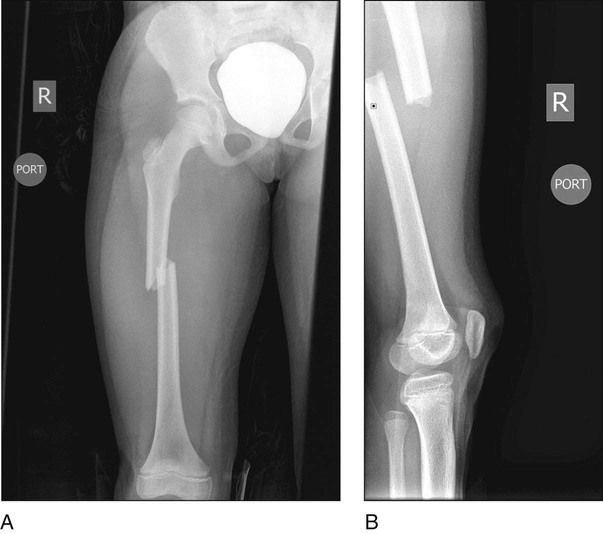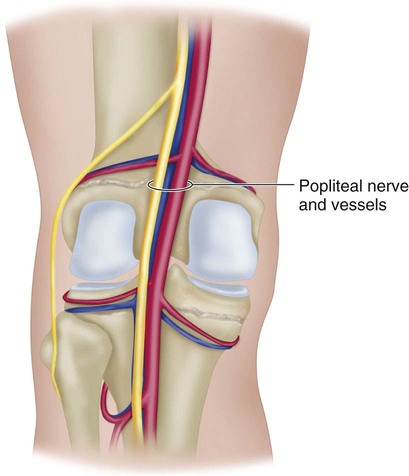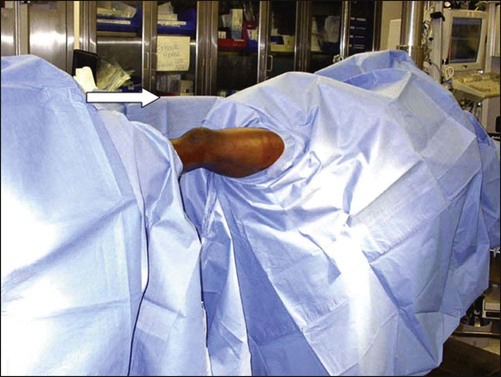• Note the mechanism of injury. • Examine the skin, surrounding soft tissue, and neurovascular status. In isolated femur fracture, the thigh is swollen and bruised. • Examine other organs and injuries in cases of high-energy trauma. • Figure 1 shows AP (Fig. 1A) and lateral (Fig. 1B) radiographs of a mid-diaphyseal femur fracture. • Radiographs should include one joint above and below the fracture. • The affected leg is abducted 15–30°, allowing working on both sides of the femur (Fig. 3). • The white arrow between the legs in Figure 3 depicts the position of the image intensifier.
Femur Fracture
Flexible Intramedullary Nailing
Examination/Imaging
 A thorough physical examination is conducted.
A thorough physical examination is conducted.
 Good-quality anteroposterior (AP) and lateral radiographs of the femur are required for diagnosis and planning.
Good-quality anteroposterior (AP) and lateral radiographs of the femur are required for diagnosis and planning.

 A computed tomography scan may help in complex fracture patterns and to identify other associated injuries such as stress fracture or intra-articular injuries.
A computed tomography scan may help in complex fracture patterns and to identify other associated injuries such as stress fracture or intra-articular injuries.
Surgical Anatomy
 The distal femoral physis is marked under fluoroscopy to avoid any inadvertent injury to the physis.
The distal femoral physis is marked under fluoroscopy to avoid any inadvertent injury to the physis.
 The popliteal vessels and the nerve are posterior to the femur at the surgical site (Fig. 2). Avoid slippage of the drill posteriorly while drilling the lateral and medial holes.
The popliteal vessels and the nerve are posterior to the femur at the surgical site (Fig. 2). Avoid slippage of the drill posteriorly while drilling the lateral and medial holes.

Positioning
 The patient is positioned supine on a radiolucent table or a fracture table (our preference).
The patient is positioned supine on a radiolucent table or a fracture table (our preference).
 Smaller children (usually < 8 years old) may be better positioned on a radiolucent table, while bigger children (>8 years old) are best positioned on a fracture table.
Smaller children (usually < 8 years old) may be better positioned on a radiolucent table, while bigger children (>8 years old) are best positioned on a fracture table.
 On the fracture table, the foot of the affected extremity is placed in the foot holder attached to the traction device.
On the fracture table, the foot of the affected extremity is placed in the foot holder attached to the traction device.

 The unaffected foot is placed in a similar foot holder with the hip in extension (scissor position of the well leg) or 15° of abduction. Due to reports of compartment syndrome, we avoid positioning the unaffected leg in a flexed, abducted position of the hip over the patient.
The unaffected foot is placed in a similar foot holder with the hip in extension (scissor position of the well leg) or 15° of abduction. Due to reports of compartment syndrome, we avoid positioning the unaffected leg in a flexed, abducted position of the hip over the patient.
 If it is not possible to place traction through the foot of the affected extremity, a traction pin may be inserted in the proximal tibia.
If it is not possible to place traction through the foot of the affected extremity, a traction pin may be inserted in the proximal tibia.
Procedure
Step 1
 After adequate positioning of the patient on a fracture table, the fracture is reduced as best as possible. The leg is prepared and draped in a standard manner either on the fracture table or on a radiolucent table.
After adequate positioning of the patient on a fracture table, the fracture is reduced as best as possible. The leg is prepared and draped in a standard manner either on the fracture table or on a radiolucent table.
 The distal femoral physis is identified under an image intensifier (Fig. 4), and the nail entry sites are marked 2 cm proximal to the physis on the medial and lateral distal femoral metaphyses.
The distal femoral physis is identified under an image intensifier (Fig. 4), and the nail entry sites are marked 2 cm proximal to the physis on the medial and lateral distal femoral metaphyses.![]()
Stay updated, free articles. Join our Telegram channel

Full access? Get Clinical Tree


21: Femur Fracture: Flexible Intramedullary Nailing







